Head and shoulders trading
The head and shoulders pattern is a technical formation that suggests a pattern reversal is underway. For traders, it is a very useful pattern, whether they are trend trading and wish to look out of prospective danger or they wish to catch a pattern reversal near the turning point.
In this short article, we check out how head and shoulders patterns can be used to identify entry and exit points for a trade, as part of technical analysis. It is important that traders find out how to identify and scan for this technical analysis pattern, and comprehend what it is telling you when it appears. We will also look at examples of head and shoulders trading in action throughout sags and uptrends, and how you can include technical analysis into your trading technique.
What is a head and shoulders pattern?
Head and shoulders patterns can be used to highlight cost action within a vast array of markets, consisting of forex trading, indices, stocks and cryptocurrencies. This makes it a simple and especially versatile pattern for traders to find on rate charts.
Head and shoulders formation
When the head and shoulders pattern occurs within an uptrend, the pattern begins with the cost increasing and then pulling back (lower), forming the left shoulder. The cost rallies again, producing a higher peak, which is known as the peak of the head. The cost relocations lower once again, and then rallies into a lower peak, forming the ideal shoulder.
When the cost drops following the left shoulder and the head, these are called swing lows. Linking the swing lows with a trendline, extended off to the right, forms a “neckline”. When the price falls listed below the neckline, the pattern is considered total and the price is likely to continue moving lower.
Example of a head and shoulders pattern
Below is an example of a head and shoulders pattern that formed on a Bitcoin candlestick chart. After forming the left shoulder, head, and right shoulder, the cryptocurrency dropped through the neck line, signaling that it would continue declining.
In this case, the best shoulder is rather small. The truth the price could not bounce considerably back toward the head showed there was great deals of selling pressure prior to the decrease. This is what is called a head and shoulders leading chart pattern.
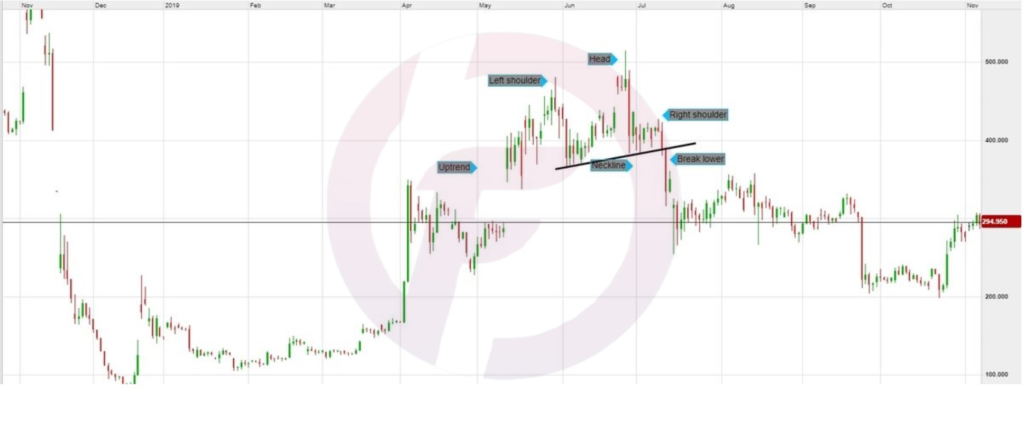
Inverted head and shoulders pattern
An inverted head and shoulders pattern occurs in a sag. The price is dropping and then has a temporary rally, forming the left shoulder. The swing highs (rally highs) following the left shoulder and head are connected with a pattern line to form the neckline.
Here, we can see Macy’s share rate declining up until it forms an inverse head and shoulders pattern. When the cost relocations above the neckline, there is a pattern reversal to the advantage. This is also called a head and shoulders bottom pattern.
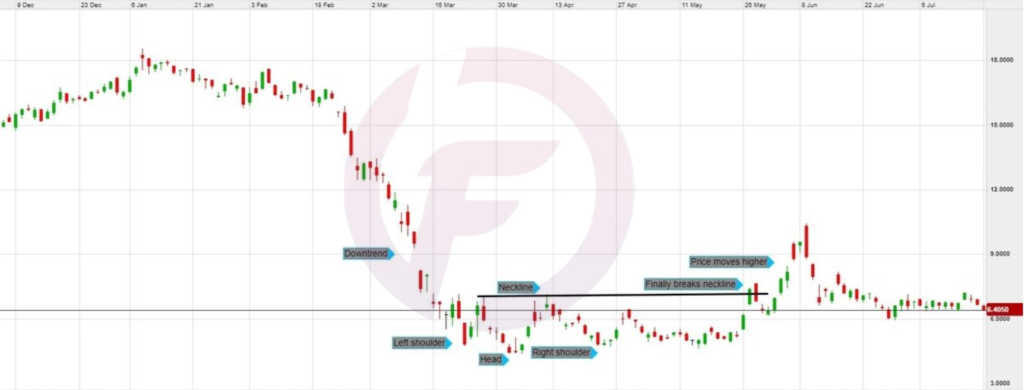
How to draw a head and shoulders pattern
You can recognize head and shoulders patterns on trading charts, whether these be candlestick or Renko charts, using different drawing tools to identify assistance and resistance levels and trendlines. Our online trading platform, Next Generation, has a wide range of drawing tools, cost forecast tools and chart types to display your positions clearly. Follow the steps listed below to start:
- Open a live account to get going straight away, or practice first with virtual funds on our demonstration account.
- Open a live chart by selecting an instrument from the Product Library. We provide over 330 forex pairs and 8500 shares on our platform, in addition to other popular monetary possessions.
- Along the bottom of the chart, you will see numerous tools: Timeframe, Draw Tools, Technical and Patterns. For head and shoulders patterns, choose the Draw Tools tab.
- To draw lines over the cost action to better see the head and shoulder patterns, or to draw the neck line, pick the Pattern tool, and then click where you desire the line to finish and start. This way, you can see the head and shoulder pattern more clearly.
- Likewise beneficial is the Note tool, which can likewise be found in the Draw Tools menu. Select it and click the chart where you want to put a note, such as “left shoulder” or “peak of head”. This will help you to bear in mind the head and shoulders development.
Drawing a head and shoulders pattern with the help of our platform illustration tools helps traders to analyses the head and shoulders patterns that appear on similar price charts.
Head and shoulders trading strategy: entry, stop loss and earnings target
The entry chance on a head and shoulders pattern takes place when the cost breaks the neckline. When determining points of entry and exit on a rate chart, you ought to make sure that you have an adequate threat management strategy in place. A stop-loss order is generally positioned above the ideal shoulder for a topping pattern and is positioned below the right shoulder for a bottoming pattern.
For a projected revenue target or cost target, you might measure the range of the pattern from low to high and add it to the neckline breakout point for a bottoming pattern (an inverse head and shoulders). Then, you might subtract the height of the pattern from the neck line breakout point for a topping pattern.
The height, or distance, is measured from the peak of the head to the most affordable swing low within the topping pattern. If one of the swing lows was severe (creating an extremely steeply angled neck line), you can utilize the higher swing low to generate a smaller sized height and for that reason a more conservative rate target. For a bottom pattern, the height is the bottom of the head to the top of the greatest swing high within the pattern. If among the swing highs was extreme, you can utilize the lower swing high that will lead to less height and, again, a more conservative revenue target.
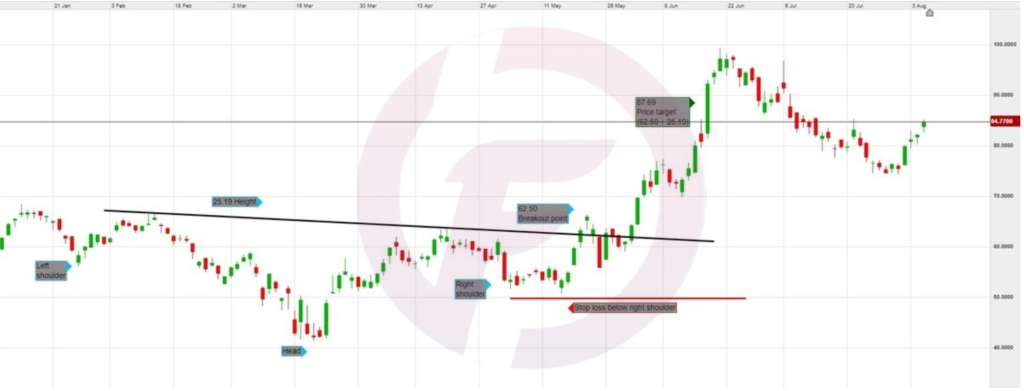
Head and shoulders pattern screener
Head and shoulders patterns are tradable, supplying chances for entry, stop loss, and earnings targets. To do this, pattern recognition software application can be useful for identifying head and shoulders patterns on charts. Our award-winning Next Generation platform consists of a chart pattern scanner, not just for head and shoulders, however numerous other patterns too, such as cup and handle and double top/bottom patterns.
It might be too large or too little to trade, or the pattern may not be visible. Pattern acknowledgment is a good starting point for discovering patterns, however it is also an excellent idea to analyses the outcomes by hand to find patterns that look like the examples revealed in this guide.
Head and shoulders patterns: are they bullish or bearish?
The appearance of a head and shoulders is not at first bullish or bearish up until there is a breakout. An inverse bottoming pattern might form, but until the rate breaks above the neck line and keeps moving higher, the price might still be in a drop. If the rate breaks listed below the pattern, that signals an extension of the drop, not a reversal.
When a topping pattern types, this does not indicate that the cost will reverse. If a head and shoulders forms but the price rallies above the pattern rather of dropping below it, this signifies an extension to the upside, not a reversal to the disadvantage.
Head and shoulders in forex
Head and shoulders patterns happen in all markets, including forex trading, and the pattern is traded in the same way. Below is an example utilizing the significant currency set GBP/USD, with entry, stop loss and earnings target opportunities marked utilizing our online trading software application.
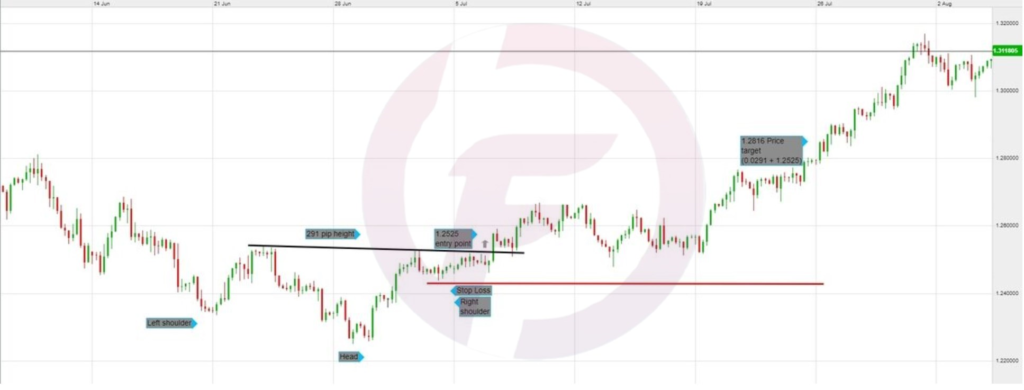
Stocks with a head and shoulders pattern
With stocks, you can search for an uptrend where the cost has actually formed 3 peaks, with the middle peak being the highest. Make sure to place a stop loss, and wait to offer or short stock until the cost relocations below the neck line. The default location for the stop loss is above the ideal shoulder, however to lower the size of the possible loss, you could place it above any swing high that preceded the neckline breakout.
Calculate the height of the pattern, then subtract that amount from the breakout point to achieve a revenue target. Below is an example utilizing the Apple stock chart, with a pattern height of 21.09. For a setup that supplies a buy signal, traders should search for an inverted head and shoulders pattern, as seen in the Macy’s share example that we pointed out earlier in this post. Learn more about stock chart patterns here.
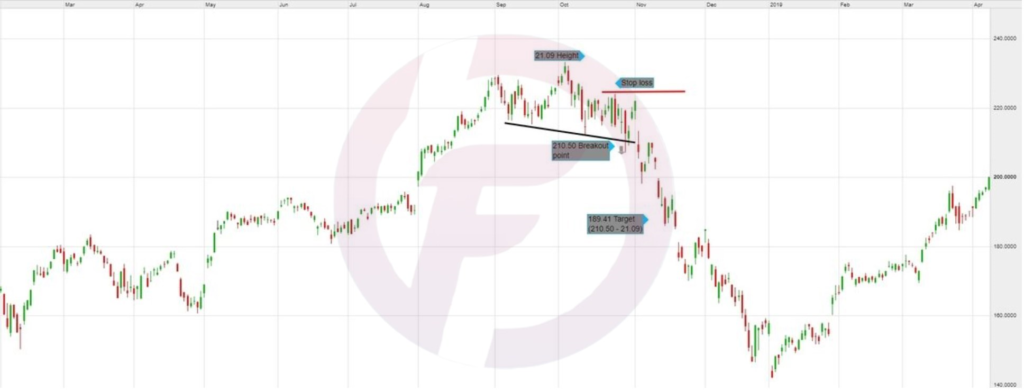
How reputable is the head and shoulders pattern?
The head and shoulders pattern can mark the end of an uptrend or drop, however you ought to wait on the price to break through the neckline before acting, as this is the point where the cost turnaround is often verified. It is common to determine the distance or height of the pattern for an approximated earnings target, utilize the right shoulder for stop loss placement, and the neck line for an entry point (or perhaps an exit signal).
Similar to all advanced technical analysis patterns, there are both drawbacks and advantages when it comes to trading head and shoulders chart patterns. The revenue target is an estimate, implying that not just will the price not necessarily go that far, but it could likewise run much further.
Some traders will opt to focus on patterns with specific attributes. This improves the risk-to-reward ratio of the trade, because while the revenue price quote is based on the whole height of the pattern, the stop loss is just based on the much smaller range between the neckline and the ideal shoulder.
When the head and shoulders pattern occurs within an uptrend, the pattern starts with the cost rising and then pulling back (lower), forming the left shoulder. A stop-loss order is typically placed above the ideal shoulder for a topping pattern and is put listed below the ideal shoulder for a bottoming pattern.
To do this, pattern acknowledgment software can be beneficial for determining head and shoulders patterns on charts. Our award-winning Next Generation platform consists of a chart pattern scanner, not simply for head and shoulders, however many other patterns as well, such as cup and manage and double top/bottom patterns.
Pattern recognition is a good starting point for discovering patterns, but it is also an excellent concept to analyses the results by hand to find patterns that resemble the examples revealed in this guide.
WHERE TO CONTACT US:
Website: www.flashtrade1.com
Twitter: twitter.com/flashtrade11
Telegram: telegram.me/ft113
Facebook: www.facebook.com/FlashTrade1
Instagram: www.instagram.com/flashtrade1/
You Tube: www.youtube.com/FlashTrade1
Skype: flashtrade1@outlook.com
Mail ID: info.flashtrade@gmail.com